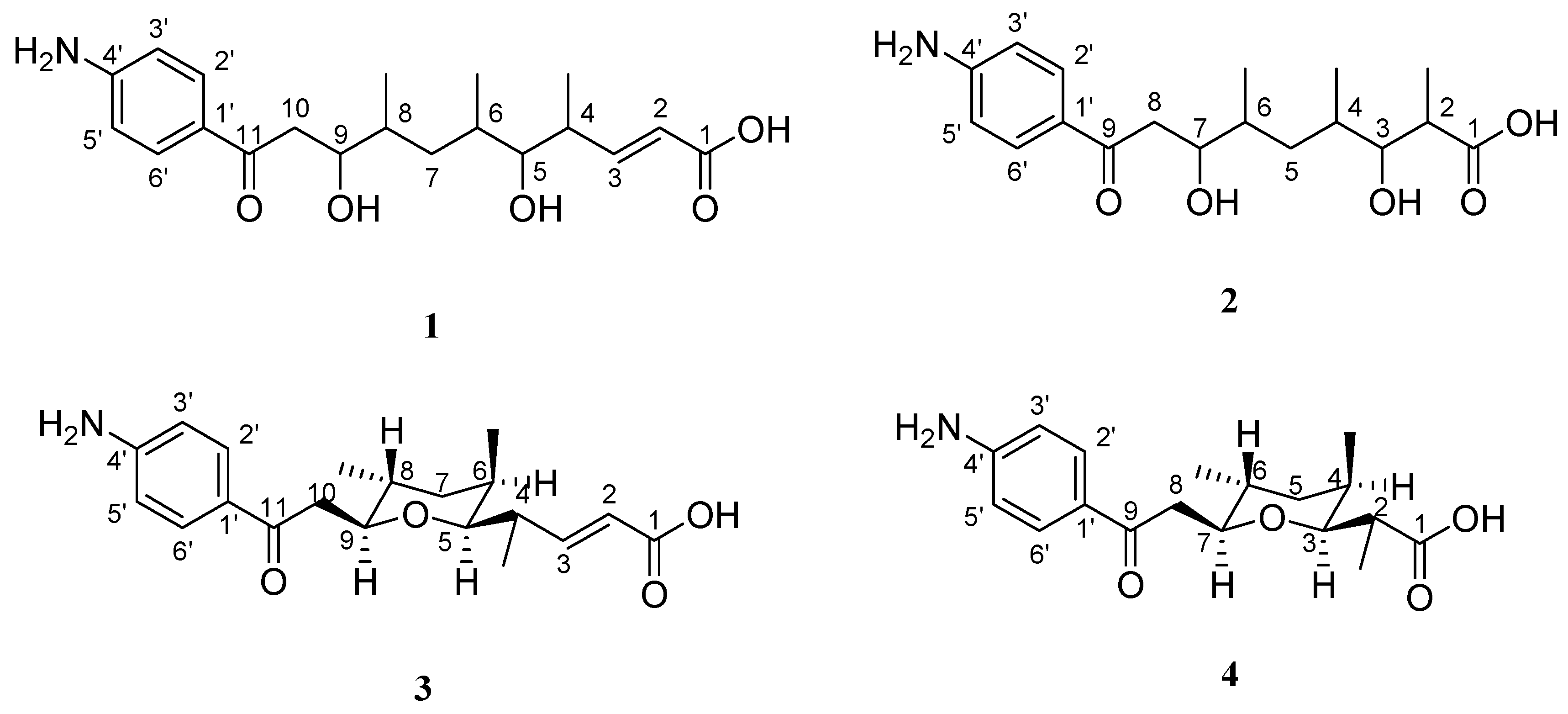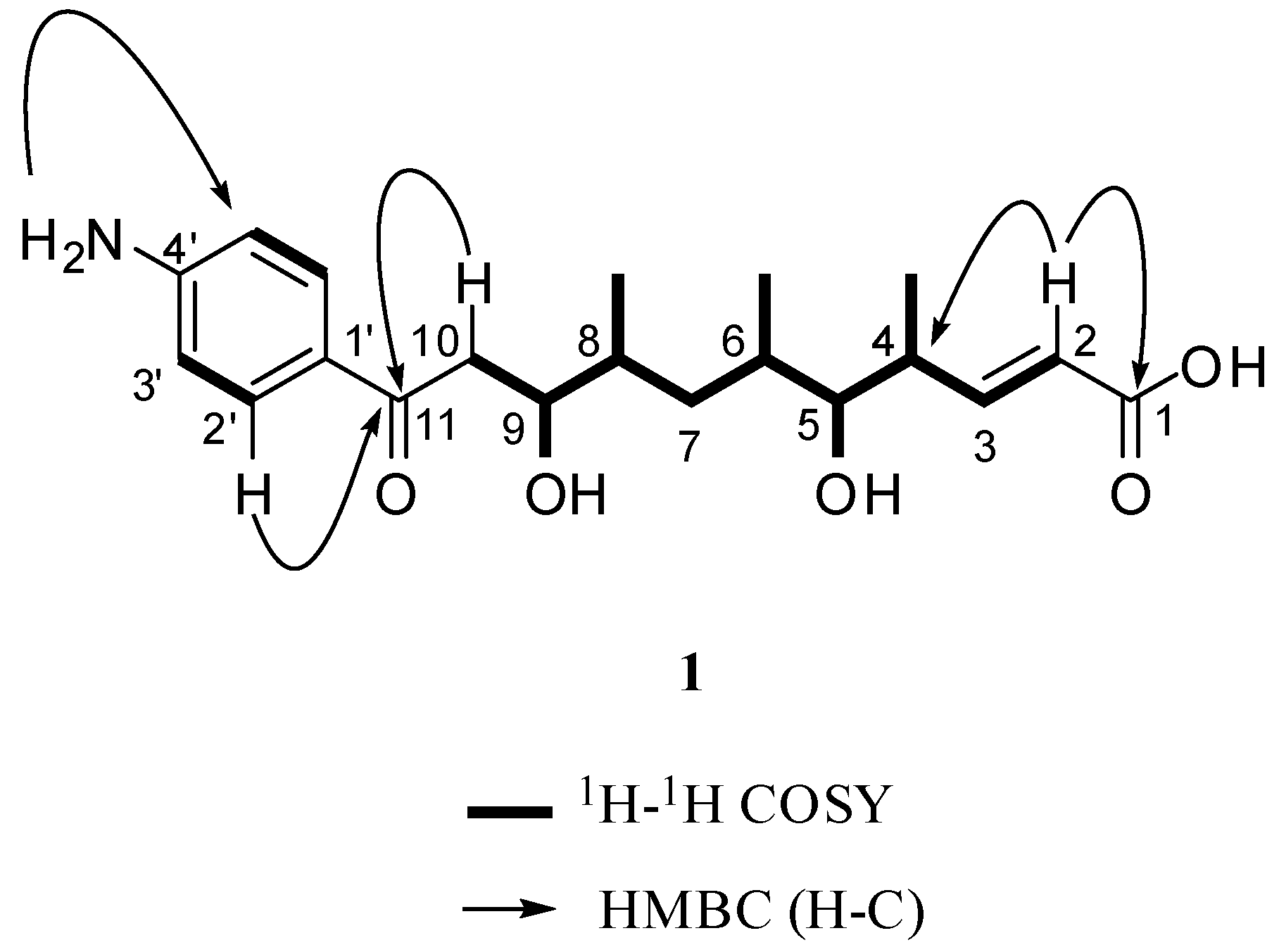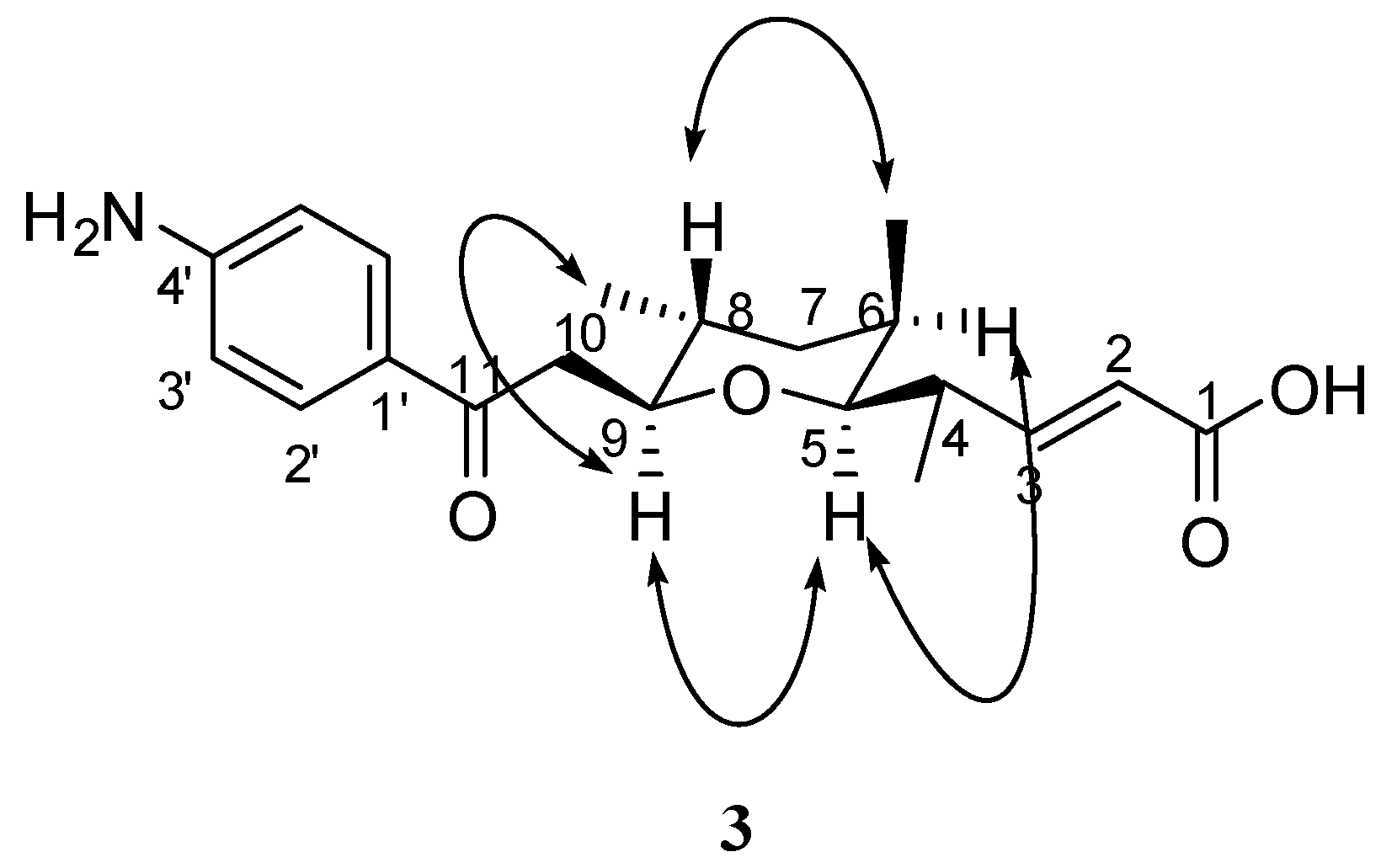1. Introduction
Mangrove endophytes, including actinomycetes and fungi, have been recognized as rich sources of structurally unique and biologically active secondary metabolites [
1]. It was reported that 58.3% from 60 strains of endophytic fungi, isolated from mangrove plant
Aegiceras corniculatum, Excoecaria agallocha, Kandelia candel, Bruguiera gymnorrhiza, Avicennia mariana, Heritiera littoralis, have antibacterial activities and 81.7% strains have antifungal activities [
2].
In general, the production of secondary metabolites is potentially useful for pharmaceutical and agricultural applications [
3]. Our previous investigation of endophytic microorganisms from mangrove plants resulted in a number of bioactive and structurally unique metabolites: new pyrrole and indole alkaloids from an endophytic
Fusarium incarnatum isolated from
A. corniculatum [
4], new cyclopentenone derivatives from another endophytic
Streptomyces sp. [
5], indole triterpenoids [
6], polyketides [
7], and penicillenols [
8] were isolated from endophytic
Penicillium sp. associated with
A. corniculatum. The indole triterpenoids showed blocking activity on large-conductance calcium-activated potassium channels [
6,
9].
In the course of ongoing investigations on natural products for the metabolic relationship between mangrove plants and their endophytes, an actinomyces (strain HK10552) was isolated from the leaves of
A. corniculatum (Aegicerataceae). This strain produced four new
p-aminoacetophenonic acids, whose derivatives were previously isolated from a mangrove endophyte
Streptomyces griseus subsp. [
10], namely (2
E)-11-(4′-aminophenyl)-5,9-dihydroxy-4,6,8-trimethyl-11-oxo-undec-2-enoic acid (
1), 9-(4′-aminophenyl)-3,7-dihydroxy-2,4,6-trimethyl-9-oxo-nonoic acid (
2), (2
E)-11-(4′-aminophenyl)-5,9-
O-cyclo-4,6,8-trimethyl-11-oxo-undec-2-enoic acid (
3) and 9-(4′-aminophenyl)-3,7-
O-cyclo-2,4,6-trimethyl-9-oxo-nonoic acid (
4) (
Figure 1), along with several known compounds, like 4-methylamino-benzoic acid, methyl-2-(2-hydroxyphenyl)acetate, 4-hydroxybenzoic acid, (2
E)-3-(4-hydroxy-3-methoxyphenyl)-2-propenoic acid, methyl-2-(1H-indol-3-yl)acetate, (2
E)-(4-hydroxyphenyl)-2-propenoic acid, (2
E)-(4-hydroxyphenyl)-2-propenoic acid, 1H-indole-3-acetic acid, indole-3-carboxylic acid, cyclo(phenylalanyl-seryl)-3,3-bis(30-indolyl)propane-1,2-diol and 2-hydroxybenzeneacetic acid. In this paper, we report the structural elucidation of the new
p-aminoacetophenonic acids
1–4.
2. Results and Discussion
Compound
1 was isolated as a yellow oil and its molecular formula was determined to be C
20H
29NO
5 on the basis of HRESIMS analysis (364.21266 [M+H]
+, calcd. for C
20H
30NO
5,
m/
z 364.21185), which indicated seven degrees of unsaturation. In the
1H NMR spectrum three methyl groups at δ
H 0.76 (d,
J = 6.36 Hz), 0.80 (d,
J = 6.55 Hz) and 0.97 (d,
J = 6.32 Hz), and two exchangeable protons at
δ 4.35 (brs, OH-9) and 4.54 (brs, OH-5) were detected (See
Table 1). Carbon signals of the
13C-NMR spectrum at δ
C 153.9 and 168.0 indicated an olefinic bond, which was supported by the correlation signal of two relevant protons at δ 5.73 (1H, d,
J = 15.73 Hz) and δ 6.85 (1H, m) in the
1H-
1H COSY spectrum (see
Figure 2.). This olefinic bond was assigned to be
E-configurated on the basis of its large vicinal coupling constant of 15.73 Hz [
11]. The substituted position of the double bond in the aliphatic chain was deduced by the correlation from H-2 to C-4 in HMBC spectrum and the correlation signal between H-3 and H-4 in
1H-
1H COSY spectrum. An attached carboxylic acid group at the double bond was assigned on the basis of the high-field carboxy signal at δ 168.0 and the HMBC correlation from H-2 to C-1. Quarternary carbon signals at δ 197.3 and 168.0 implied the presence of keto-carbonyl acid groups. The
1H-
1H COSY correlations confirmed the assembly of the aliphatic chain between H-2 and H
2-10 and the position of Me-4, OH-5, Me-6, Me-8 and OH-9. Aromatic proton signals at δ 6.55 (2H, d,
J = 8.41 Hz), 7.68 (2H, d,
J = 8.42 Hz) were attributed to a
p-disubstituted phenyl moiety, the assignment of which was supported by carbon signals at δ 125.7 (C-1′), 131.0 (C-2′), 112.9 (C-3′), and 153.9 (C-4′) in the
13C-NMR spectrum. One of the substituted groups of the aromatic ring was 4´-NH
2 (6.02, s), which was deduced from the HMBC correlation between C-3´ and 4´-NH
2 (6.02, s) and the aminophenonic moiety was linked to C-11 as deduced from the HMBC correlation between H-2´ and C-11 (see
Figure 2). Thus, compound
1 was determined as (2
E)-11-(4-aminophenyl)-5,9-dihydroxy-4,6,8-trimethyl-11-oxo-undec-2-enoic acid (
1).
Compound 2 was isolated as a yellow oil. The determination of its molecular formula C18H27NO5 was based on HRESIMS analysis (338.19701 [M+H]+, calcd. for C20H30NO5, m/z 338.19620), which indicated the molecule with six degrees of unsaturation. Comparison of 1H- and 13C-NMR data of 2 with those of 1 showed that 2 was a homologue of 1 with the olefinic bond missing. The newly found HMBC correlations from H-2 (2.36, m) to C-1 (176.5, s) confirmed the suggested structure. Therefore, 2 was elucidated to be 9-(4-aminophenyl)-3,7-dihydroxy-2,4,6-trimethyl-9-oxo-nonoic acid (2).
Compound
3, a yellow oil, was determined to be C
20H
27NO
4 on the basis of its HRESIMS data (346.20109 [M+H]
+, calcd for C
20H
28NO
4,
m/
z 346.20128), requiring eight degrees of unsaturation. According to the comparison of mass spectral data between
3 and
1, there is 18 amu missing suggesting that
3 was the product of dehydration-condensation from
1. Compound
3 contained similar structural elements as
1, expect for the two missing hydroxyl groups, as observed in the
1H-NMR spectrum. The carbon signals at δ 29.3 (d, C-6), 30.2 (d, C-8) were shifted remarkably to highfield by 4–8 ppm as compared with
1, while signals at δ 82.8 (d, C-5), 81.7 (d, C-9) were moved downfield for 6–9 ppm, indicating that the attached two hydroxyl groups of
1 were condensed to form a pyran-ring in
3. The HMBC correlations from H-5 (3.06, d,
J = 9.62 Hz) to C-9 (81.7, d) confirmed this finding. The relative stereoconfiguration of
3 was determined on the basis of as NOESY experiment. NOE effects were observed between H-5/H-6, H-5/H-9 and Me-8/H-9 (see
Figure 3) indicating that H-5, H-6, H-9, Me-8 were on the same side of the ring with
α-orientation, and in turn H-8 and Me-6 were assumed to be in
β-orientation confirmed by an NOE correlation between H-8 and Me-6. Thus, compound
3 was (2
E)-11-(4′-aminophenyl)-5,9-
O-cyclo-4,6,8-trimethyl-11-oxo-undec-2-enoic acid (
3).
Compound 4, was also isolated as a yellow oil. Its molecular formula was determined to be C18H25NO4 on the basis of its HRESIMS data (320.18587 [M+H]+, calcd for C20H28NO4, m/z 320.18563) requiring seven degrees of unsaturation. 1H and 13C NMR data were suggesting that compound 4 held a similar structure as that of 3, except for a missing double bond, as observed in the 1H NMR spectrum. HMBC correlations between H-3 (3.45, m) and C-7 (81.0, d) and C-1 (176.7, s) confirmed this finding. The relative stereoconfiguration of 4 was determined on the basis of an NOESY experiment. NOE correlations of H-4/H-7, H-4/H-3, H-6/Me-4, and Me-6/H-3, Me-6/H-7 indicated that H-3, H-4, H-7, Me-6 were located on the same side of the ring and suggesting to have a α-orientation, and in turn H-6 and Me-4 were assumed to be in the β-orientation. Thus, compound 4 was 9-(4′-aminophenyl)-3,7-O-cyclo-2,4,6-trimethyl-9-oxo-nonoic acid (4).
In cytotoxicity testing against Hela cells compounds 1–4 showed no cytotoxicity (IC50 > 100 μg/mL). In further testing, compound 4 proved to be inactive against HCV protease and SecA ATPase and did not inhibit VSVG/HIV-luc pseudotyping virus on 293T cell line.
Compounds
1 and
2 show certain structural similarity to the polyene antibiotics, e.g. candicidin produced by
Streptomyces griseus, which consists of the aromatic moiety, the macrolide ring and the amino sugar moiety. Compounds
1 and
2 have different polyketide chain lengths which may be due to different biosynthetic polyketide assembly procedures. It was reported the the
p-aminoacetophenone moiety of candicidin is synthesized from chorismic acid via the aromatic amino acid pathway and
p-aminobenzoic acid (PABA) has been identified as the immediate precursor [
12]. The isolation of 4-methylaminobenzoic acid from the crude extract in our study suggested the presence of this biosynthetic pathway
Streptomyces sp. (strain HK10552).
Polyene macrolide antibiotics are the most effective antifungal agents due to their potent broad spectrum fungicidal activity and relatively low frequency of resistance among the fungal pathogens [
13]. Therefore, the novel derivatives of polyene antibiotics discovered in our study would be a potential target for further chemical and microbiological investigations in this respect.
3. Experimental
3.1. General
1H- and 13C-NMR spectra were measured on a Bruker Avance DRX 500 spectrometer using TMS as an internal standard. Chemical shifts (δ) expressed in parts per million (ppm) and coupling constants (J) are reported in Hertz (Hz). Optical rotations were recorded on a Perkin-Elmer 341 LC polarimeter. ESIMS spectra were measured on a Quattro. Premier XE tandem mass spectrometer (Micromass, UK), while HRESIMS spectra were measured on a LTQ Orbitrap X1 Thermo Scientific and a FT-MS-Bruker APEX IV (7.0T).Column chromatography was carried with silica gel (200–300 mesh), and GF254 Silica gel for TLC was provided by Qingdao Marine Chemistry Co.. Semipreparative HPLC was performed on an Alltech-HPLC (USA) using a Kromasil column (ODS, 10 μm, 10 × 250 mm). The chemical reagents used for chromatography were purchased from Beijing Chemical Works Co. Ltd. (Beijing).
3.2. Plant Material
Leaves of A. corniculatum (Aegicerataceae) were collected near Xiamen City of Fujian Province, People’s Republic of China, in August 2002, and identified by Prof. Peng Lin of Xiamen University. Samples were deposited in the State Key Laboratory of Natural and Biomimetic Drugs, Peking University (No.200208082-2). Microbial materials were isolated from the leaves of the plant. The Streptomyces sp. (strain HK10552), subject of this study, was deposited in Hans-Knöll-Institute, Jena, Germany.
3.3. Strain Isolation, Characterization, and Cultivation
The strain was isolated from the mangrove plant A. corniculatum. Pieces of the leaves were rinsed with sterile water, sterilized by soaking in 70% ethanol (1 min) and 3.5% NaCl solution (3 min), and rinsed again with sterile water. Tiny pieces obtained by cutting with a sterile knife were placed on agar plates with GPY agar, which was supplemented with streptomycin (0.1 g/L) and chloramphenicol (0.2 g/L), and incubated at 22 ºC until growth appeared. Colonies were transferred to fresh agar plates for further growth. General laboratory cultivation was performed on malt agar [malt extract 20.0 g/L, yeast extract 2.0 g/L, glucose 10.0 g/L, (NH4)2HPO4 0.5 g/L, pH 6.0] or the respective liquid medium at 22 ºC. For long-term preservation, cultures grown on agar plates supplemented with 5% glycerol were maintained in the vapor phase of liquid nitrogen. The strain isolate has been deposited in the strain collection of the Leibniz Institute for Natural Products Research and Infection Biology.
For screening purposes, the strain was grown in 250 mL Erlenmeyer flasks with 100 mL of the production culture medium, consisting of saccharose 20 g/L, soybean flour10 g/L, cornsteep 10 g/L, and KCl 8 g/L, adjusted to pH 6.5 prior to sterilization. It was inoculated with pieces (1 × 1 cm2 from an agar plate of a well grown culture and cultivated as resting culture for 17 days at 22 ºC. The production culture was carried out in a 300 L fermentor filled with 200L of the above production medium; it was grown for 10 days at 22 ºC (aeration 50 L/min, pH 6.5) and stirred at 125 rpm. The inoculum (2 L) was obtained after several steps of resting cultures with increasing cultivation volume in a modified malt extract medium [malt extract 10.0 g/L, yeast extract 4.0 g/L, glucose 4.0 g/L, (NH4)2 HPO4 0.5 g/L, pH 5.5].
3.4. Extraction and Isolation
Fermentation supernatant of Streptomyces sp. (strain HK10552) was filtered by centrifugation and subjected to a XZD-161M resin column (20 × 20 cm) eluted with MeOH/H2O (gradient from 40:60 to 90:10 in 38 min). Seven fractions were collected and lyophilized. Fractions 5-6 (total 2g) was further purified on Sephadex LH-20 eluted with MeOH (900 mL) to give six subfractions. Subfraction 6 (900 mg) was separated on a RP-18 silica gel column eluted with MeOH/H2O (gradient from 10:90 to 88:12, 1800 mL) to give six fractions (T1-T6). Fraction T2 (88.6 mg) and T3 (30.2 mg) was purified by semi-preparative HPLC with MeOH–H2O (1:1) as a mobile phase to yield compound 1 (13.9 mg) and 2 (19.6 mg). T4 (119.8mg) and T5 (88.2mg) was followed by the same way as T2 with MeOH–H2O (7:3) as a mobile phase to obtain 3 (29.7 mg) and 4 (40.9 mg).
(2E)-11-(4-Aminophenyl)-5,9-dihydroxy-4,6,8-trimethyl-11-oxo-undec-2-enoic acid (
1). Yellow oil;
-20.0º (
c 0.015, MeOH); UV
λ max (MeOH) 318, 206 nm; IR (KBr)
νmax 3,733, 3,357, 2,964, 2,931, 1,698, 1,650, 1,595, 1,379, 1,175, 826 cm
-1;
1H- and
13C-NMR data, see
Table 1; ESIMS
m/
z positive 364.4 [M + H]
+; HRESIMS
m/
z 364.21266 [M + H]
+ (calcd for C
20H
30NO
5,
m/
z 364.21185).
9-(4-Aminophenyl)-3,7-dihydroxy-2,4,6-trimethyl-9-oxo-nonoic acid (
2). Yellow oil;
+1.35º (
c 0.07, MeOH); UV
λ max (MeOH) 319, 231, 195 nm; IR (KBr)
νmax 3,733, 3,515, 3,446, 3,354, 2,961, 2,933, 2,869, 1,772, 1,651, 1,629, 1,179, 1,592, 830 cm
-1;
1H- and
13C-NMR data, see
Table 1; ESIMS
m/
z positive 338.5 [M + H]
+; HRESIMS
m/
z 338.19701 [M + H]
+ (calcd for C
18H
28NO
5,
m/
z 338.19620).
(2E)-11-(4′-aminophenyl)-5,9-O-cyclo-4,6,8-trimethyl-11-oxo-undec-2-enoic acid (
3). Yellow oil;
-35.48º (
c 0.03, MeOH); UV
λ max (MeOH) 314, 207 nm; IR (KBr)
νmax 3,448, 3,356, 3,230, 2,964, 2,911, 1,700, 1,652, 1,596, 1,381, 1,025, 1,051, 828 cm
-1;
1H- and
13C-NMR data, see
Table 1; ESIMS
m/
z positive 346.6 [M + H]
+; HRESIMS
m/
z 346.20109 [M + H]
+ (calcd for C
20H
28NO
4,
m/
z 346.20128).
9-(4′-aminophenyl)-3,7-O-cyclo-2,4,6-trimethyl-9-oxo-nonoic acid (
4). Yellow oil;
-3.66º (
c 0.04, MeOH); UV
λ max (MeOH) 316, 230,192 nm; IR (KBr)
νmax 3,448, 3,358, 3,238, 2,923, 1,720, 1,636, 1,596, 1,379, 1,025, 828 cm
-1;
1H- and
13C-NMR data, see
Table 1; ESIMS
m/
z positive 320.4 [M + H]
+; HRESIMS
m/
z 320.18587 [M + H]
+ (calcd for C
18H
26NO
4,
m/
z 320.18563).









